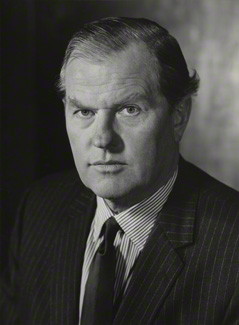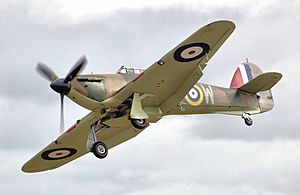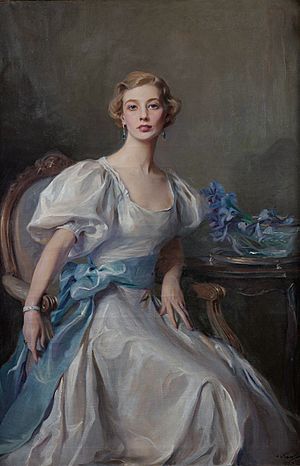John Grandy facts for kids
Quick facts for kids
Sir John Grandy
|
|
|---|---|

Marshal of the Royal Air Force Sir John Grandy
|
|
| Born | 8 February 1913 Northwood, London |
| Died | 2 January 2004 (aged 90) Slough, Berkshire |
| Allegiance | United Kingdom |
| Service/ |
Royal Air Force |
| Years of service | 1931–1971 |
| Rank | Marshal of the Royal Air Force |
| Commands held | Chief of the Air Staff (1967–71) Far East Command (1965–67) Bomber Command (1963–65) RAF Germany (1961–63) Central Fighter Establishment (1954–56) Northern Sector of Fighter Command (1950–52) No. 341 Wing (1945) No. 73 Operational Training Unit (1944–45) No. 210 Group (1943) RAF Duxford (1942–43) No. 249 Squadron (1940) No. 219 Squadron (1940) |
| Battles/wars | Second World War Indonesia–Malaysia confrontation |
| Awards | Knight Grand Cross of the Order of the Bath Knight Grand Cross of the Royal Victorian Order Knight Commander of the Order of the British Empire Distinguished Service Order Knight of the Venerable Order of Saint John Mentioned in Despatches (2) Commander of the Order of the Defender of the Realm (Malaysia) |
| Other work | Governor of Gibraltar Constable and Governor of Windsor Castle |
Marshal of the Royal Air Force Sir John Grandy (born February 8, 1913 – died January 2, 2004) was a very important officer in the Royal Air Force (RAF). He was the only officer who fought and led a squadron during the famous Battle of Britain to later become the Chief of the Air Staff. This is the highest rank in the RAF. In this top role, he helped the RAF leave the Persian Gulf and the Far East. He also managed the ordering and then cancelling of the F-111 strike aircraft. Plus, he passed on Britain's nuclear defence job to the Royal Navy.
Contents
Sir John Grandy's Amazing Career
John Grandy went to school in London. He joined the Royal Air Force as a pilot officer on September 11, 1931. After finishing his flight training, he became a pilot with No. 54 Squadron in August 1932. He flew planes called Bulldogs from RAF Hornchurch. He was promoted to flying officer in June 1933.
Early Days in the RAF
In April 1935, he became an Adjutant (a type of assistant officer) for No. 604 (County of Middlesex) Squadron. He also went to a special course to become an instructor in January 1936. He was promoted again to flight lieutenant in June 1936. In January 1937, he worked as an Adjutant for the University of London Air Squadron.
World War II Hero
Grandy served bravely during the Second World War. At first, he was a Squadron Commander at a training school. In April 1940, he took command of No. 219 Squadron. They flew Blenheim planes for night patrols from RAF Catterick. A month later, he commanded No. 249 Squadron. This squadron flew Hurricanes from RAF Church Fenton during the Battle of Britain.
His squadron was incredibly successful. They shot down more German planes than any other squadron during the Battle of Britain. One of his pilots even won the Victoria Cross, which is a very high award for bravery. In September 1940, Grandy himself was shot down and had to go to the hospital.
In December 1940, he joined the Air Staff at RAF Fighter Command. He was promoted to wing commander in March 1941. In November 1941, he went to RAF Duxford. There, he was put in charge of all flying operations. By February 1942, he was in overall command of RAF Duxford. He helped set up the RAF's first Typhoon Wing there. He was mentioned for his bravery in official reports in January 1943.

Fighting in North Africa and Asia
In February 1943, Grandy was given command of No. 210 Group RAF. Their job was to protect the Port of Tripoli. Then, in September 1943, he moved to Egypt. There, he commanded No. 73 Operational Training Unit. He was promoted to the temporary rank of group captain in July 1944. In February 1945, he became the Officer Commanding No. 341 Wing. This unit was fighting against the Japanese in the Far East.
In September 1945, he became a Senior Air Staff Officer. He received the Distinguished Service Order award in October 1945 for his excellent service.
Post-War Leadership
After the war, Grandy worked at the Air Ministry from 1946. He became an Air Attaché (a military diplomat) in Brussels in January 1949. He was promoted to group captain in January 1950. In November 1950, he became the Officer Commanding the Northern Sector of Fighter Command.
He later became the Commandant of the Central Fighter Establishment in December 1954. He received another honour, being appointed a Companion of the Order of the Bath in 1956. He was promoted to air commodore in January 1956. After attending a defence college, he became Commander of Operation Grapple in September 1957. This was a program for testing the Hydrogen Bomb. He was promoted to air vice marshal in December 1957.
Top Commander Roles
In January 1961, Grandy was promoted to air marshal. He became the Commander-in-Chief of RAF Germany. He also led the RAF Second Tactical Air Force. He was made a Knight Commander of the Order of the British Empire in 1961. This meant he could be called "Sir John Grandy."
In September 1963, he became Commander-in-Chief of RAF Bomber Command. He was further honoured as a Knight Commander of the Order of the Bath in 1964. In May 1965, he became the Commander-in-Chief, Far East Command. This was during the end of the Indonesia–Malaysia confrontation. He was promoted to air chief marshal in April 1965.
In April 1967, Sir John Grandy became the Chief of the Air Staff. This is the highest position in the RAF. He was the only officer from the Battle of Britain to reach this rank. As Chief of the Air Staff, he managed the RAF's final departure from the Persian Gulf and the Far East. He also oversaw the decision to order and then cancel the F-111 strike aircraft. He retired on March 31, 1971. The very next day, he was promoted to Marshal of the Royal Air Force, the highest possible rank.
Later Work and Life
After his military career, Sir John Grandy served as the Governor of Gibraltar from 1973 to 1978. Gibraltar is a British territory. Then, he became the Constable and Governor of Windsor Castle from 1978 to 1988. This is a special role at the famous castle.
He was also made a Knight of the Venerable Order of Saint John in 1974. In 1988, he received another high honour, becoming a Knight Grand Cross of the Royal Victorian Order. He also served as the Chairman of the Trustees for the Imperial War Museum. Sir John Grandy passed away on January 2, 2004, after a stroke.
Family Life
In 1937, he married Cecile Rankin. They had two sons together. Sir John Grandy enjoyed playing golf and was a member of the Royal Yacht Squadron.


